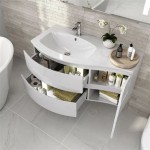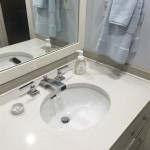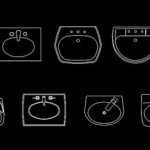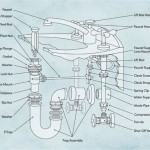Narrow Depth Bathroom Vanity Cabinets: Maximizing Space in Compact Bathrooms
Bathroom vanities are essential components of any bathroom, providing storage, concealing plumbing, and enhancing the overall aesthetic. However, traditional vanity sizes can be prohibitive in smaller bathrooms, leading to cramped conditions and limited functionality. Narrow depth bathroom vanity cabinets offer a practical solution for maximizing space and optimizing storage in these compact environments. These vanities, characterized by their reduced depth compared to standard models, are specifically designed to fit comfortably into bathrooms with limited square footage, without sacrificing style or utility.
Selecting the right bathroom vanity involves careful consideration of several factors, including dimensions, style, storage capacity, and material. When space is at a premium, narrow depth options become particularly appealing. This article explores the benefits and considerations associated with narrow depth bathroom vanity cabinets, providing guidance for homeowners and interior designers seeking to create functional and stylish bathrooms in confined spaces.
Understanding the Dimensions of Narrow Depth Vanities
The defining characteristic of a narrow depth bathroom vanity is its reduced depth measurement. Standard bathroom vanities typically range from 18 to 24 inches in depth. Narrow or slim depth vanities, conversely, generally range from 12 to 18 inches. This difference, albeit seemingly small, can significantly impact the amount of usable floor space in a bathroom, particularly in tight corners or narrow layouts. The availability of different widths and heights allows for customized solutions, ensuring that the vanity complements the existing bathroom fixtures and meets the storage requirements of the user.
It is crucial to accurately measure the available space before selecting a vanity. Consider the placement of doors, windows, and other fixtures to ensure adequate clearance and ease of movement. Furthermore, account for the plumbing connections, as relocating plumbing can add significantly to the cost and complexity of the installation. A detailed floor plan with precise measurements is essential for determining the optimal vanity size and configuration. Consult with a professional contractor or designer to avoid any unforeseen issues during the installation process.
The reduced depth of these vanities affects the sink basin size and style. Smaller basins are often necessary to accommodate the narrower dimensions. This may necessitate a change in user habits, such as using smaller amounts of water or being more mindful of splashing. However, the trade-off is generally considered worthwhile in exchange for the increased floor space and improved overall bathroom layout. The choice of sink material, shape, and style can also influence the visual appeal of the vanity and the overall bathroom design. Options range from traditional ceramic undermount sinks to modern glass or stone vessel sinks, each offering its own unique aesthetic and functional characteristics.
Benefits of Opting for Narrow Depth Cabinets
The primary advantage of narrow depth bathroom vanities is their space-saving capability. By minimizing the protrusion into the bathroom, these vanities create a more open and airy feel, making the room appear larger than it actually is. This is particularly beneficial in small bathrooms where every inch of space counts. In addition to the increased floor space, narrow depth vanities can also improve traffic flow, making it easier to move around the bathroom without bumping into the vanity or other fixtures.
Another key benefit is the versatility in design and style. Narrow depth vanities are available in a wide range of materials, finishes, and designs, allowing homeowners to find a style that complements their existing bathroom decor. From traditional wood vanities with intricate carvings to modern minimalist designs with sleek lines and metal accents, there are options to suit virtually any taste. The availability of different hardware options, such as knobs, pulls, and handles, further enhances the customization possibilities. Many manufacturers offer matching mirrors, medicine cabinets, and other accessories to create a cohesive and coordinated bathroom design.
Despite their smaller size, narrow depth vanities can still offer ample storage space. Clever design features, such as drawers with organizers, pull-out shelves, and hidden compartments, can maximize the available storage capacity. Some models also include open shelving, providing easy access to frequently used items, such as towels or toiletries. The key is to choose a vanity with a layout that meets the specific storage needs of the user. Consider the types of items that will be stored in the vanity and select a model with appropriate drawer and shelf configurations. Regularly decluttering the vanity and organizing its contents can further enhance its functionality and maximize the available storage space.
Considerations When Choosing Narrow Depth Vanity Cabinets
While narrow depth bathroom vanity cabinets offer numerous benefits, there are several factors to consider before making a purchase. The first is the sink style and size. As mentioned earlier, narrow depth vanities often require smaller sinks, which may not be suitable for all users. Consider the depth and width of the sink and ensure that it meets your needs in terms of functionality and comfort. A shallow sink can lead to increased splashing, while a very small sink may be difficult to use comfortably.
The second consideration is storage capacity. While narrow depth vanities can offer ample storage, they may not be sufficient for users with extensive storage needs. Assess your storage requirements carefully and choose a vanity with adequate drawer and shelf space. If you require additional storage, consider adding a medicine cabinet, wall-mounted shelves, or other storage solutions to supplement the vanity's storage capacity. Optimizing the use of vertical space can be particularly effective in small bathrooms.
The third, and equally important, consideration is the quality of materials and construction. Opt for vanities made from durable materials, such as solid wood, plywood, or high-quality MDF (Medium-Density Fiberboard). Avoid vanities made from particleboard, which is more susceptible to moisture damage and may not hold up well over time. Check the construction of the vanity carefully, paying attention to the quality of the joints, hinges, and drawer slides. High-quality hardware can significantly extend the lifespan of the vanity and ensure smooth and reliable operation. Look for vanities with warranties, which can provide added peace of mind.
Installation is another critical factor to consider. While some homeowners may be comfortable installing a vanity themselves, it is generally recommended to hire a professional plumber or contractor. Proper installation is essential to ensure that the vanity is level, secure, and properly connected to the plumbing. Incorrect installation can lead to leaks, water damage, and other problems. Furthermore, a professional installer can help ensure that the vanity meets all applicable building codes and regulations. Obtaining necessary permits and inspections is crucial to avoid any legal or safety issues.
The cost of narrow depth bathroom vanity cabinets can vary widely depending on the materials, style, and manufacturer. While it may be tempting to opt for a cheaper option, it is generally advisable to invest in a high-quality vanity that will last for many years. Consider the long-term value of the vanity and factor in the cost of potential repairs or replacements when making your decision. Comparing prices from different retailers and manufacturers can help you find the best value for your money. Be sure to factor in the cost of installation when comparing prices, as this can add significantly to the overall cost.
Finally, consider the overall style and design of your bathroom. Choose a vanity that complements the existing decor and enhances the overall aesthetic. Consider the color scheme, the style of the fixtures, and the architectural details of the room. A well-chosen vanity can be a focal point of the bathroom, adding visual interest and enhancing the overall ambiance. Consult with an interior designer or use online design tools to help you visualize different vanity styles and configurations in your bathroom. Pay attention to the details, such as the hardware, the countertop material, and the sink style, to create a cohesive and harmonious design.
Ultimately, the selection of a narrow depth bathroom vanity cabinet is a balancing act between space constraints, storage needs, and aesthetic preferences. By carefully considering these factors, homeowners can choose a vanity that maximizes the functionality and style of their small bathrooms, creating a comfortable and visually appealing space.

38 Inch Single Sink Narrow Depth Furniture Bathroom Vanity

Narrow Depth Bathroom Vanities Signature Hardware

30 Inch Narrow Depth Console Bath Vanity Custom Options

22 Inch Narrow Depth Console Bath Vanity Custom Options

The Best Shallow Depth Vanities For Your Bathroom Trubuild Construction Fairmont Designs White Storage Decor

Narrow Depth Vanity 15 To 20 In Dept Space Saving

Narrow Depth Bathroom Vanities Signature Hardware

24 Adelina Contemporary Small Slim Narrow White Bathroom Vanity

Narrow Bathroom Vanities A Simple Solution For Small

Why Do I Need An 18 Inch Deep Bathroom Vanity Anve Kitchen And Bath
Related Posts







